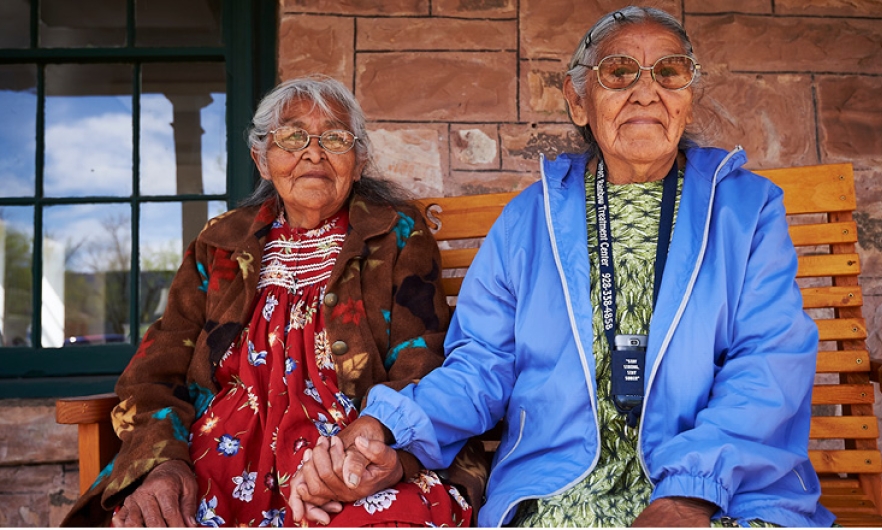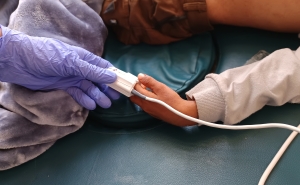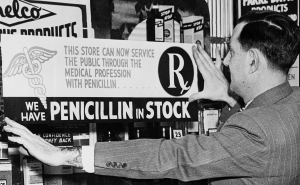Partners in Fighting Coronavirus Among Native Americans

Ed Cunicelli for the Johns Hopkins Center for American Indian Health. All Rights Reserved.
Glaring health disparities and socioeconomic factors complicate the COVID-19 response.
Jaime Begay now spends her days assembling and delivering coronavirus care kits on the Navajo Nation in Tuba City, Arizona.
The research program coordinator with the Center for American Indian Health at the Johns Hopkins Bloomberg School of Public Health fills packages with nonperishable food, household disinfectants, soap, water, paper goods, diapers, and other essentials. She then takes them to elderly residents and families with children sheltering at home.
Delivery is a three-step process. Begay, who is Navajo and from Tuba City, leaves the box at the door—but not too close—and calls the resident, who knows not to retrieve the box until Begay returns to her car.
“We’re dropping off these boxes in the safest way possible,” she says.
The project is one piece of the emergency response by the Center, which has worked closely with tribal communities to improve their health and well-being for 29 years. Center staff, the majority of whom are Native American, know well the unique challenges people face: overcrowded living arrangements, lack of running water in some homes, and some of the country’s highest rates of diabetes, heart disease, and asthma—conditions that put Native American peoples, in general, at high risk for severe COVID-19 illness.
“In multigenerational homes, eight people could be sleeping in one room—from very little children to much older adults and elders,” making social distancing impossible, says Center director Allison Barlow, PhD, MPH ’97. “There is a good proportion of homes that have no running water, and this is a pandemic where the best advice is to keep washing your hands.”
For Native Americans, the coronavirus outbreak is a reminder of the devastating losses that tribes suffered in the 1918 and 2009 flu pandemics, with mortality rates four to five times higher than in the U.S. overall.
“There’s an element of historical trauma that has been triggered by this pandemic,” Barlow says. “Because of poor health care and poverty over generations there’s now a greater proportion of Native people that have underlying health conditions that make them more vulnerable to severe illness and death.”
The federal Indian Health Service reported a total of 1,124 COVID-19 cases in IHS jurisdictions nationwide as of April 14, 2020,—with 693 confirmed cases on the Navajo Nation, the largest tribal nation in the U.S., which crosses New Mexico, Arizona, and Utah. Indian Country Today reports a total of 55 deaths in tribal communities, based on data from tribes, IHS, local health departments, and the CDC. But lack of adequate surveillance systems and widespread racial misclassification mean that the cases counts are actually much higher, Barlow says.
As part of the Center’s emergency response efforts, more than 140 Native American and allied doctors, nurses and community health workers are carrying out surveillance, education, and delivering 2,000 care kits of critical medical and household supplies in five Navajo Nation sites—Tuba City, Chinle, and Fort Defiance in Arizona; and Gallup and Shiprock in New Mexico—and on the entire White Mountain Apache tribal lands in Arizona. The Center is also sourcing personal protective equipment and health communications materials, food, and supplies to its Great Lakes Hub that serves 11 Ojibwe bands in Minnesota and Wisconsin and tribal partners in Michigan and Montana.
Additionally, the Center is building handwashing stations, and has hired tribal members to make face masks and gowns. In collaboration with the IHS, it developed COVID-19 education materials, including fact sheets, public service announcements, and social media messages that can be customized in Native languages.
These efforts are a start, but also illustrate a staggering need for strengthened health care and emergency services in tribal communities, and in some cases, for the most basic resources.
“Our Indian Health Services in general are woefully underfunded relative to other groups that receive federal money for health care, whether it’s Medicaid or money for federal prisoners,” says Melissa Walls, PhD, inaugural director of the Center’s new Great Lakes Hub in Duluth, Minnesota.
The Department of Health and Human Services in early March allocated $80 million in funding to tribal organizations to support the COVID-19 response and, in a later round of emergency funding, earmarked $10 billion for American Indians.
In the coming months, innovative ideas and approaches will be needed to promote health and safety amid the increasingly dire socioeconomic conditions in tribal communities, Barlow says.
One possibility, she notes, is converting spaces in tribal communities to alternative care sites, which would allow for more social distancing. In this care model, the sites would house people with COVID-19 who are sick but don’t need hospitalization to recover and remain separate from family members.
“We are really trying to utilize our public health and infectious disease expertise so that Indian Country has access to the best available science and data on COVID-19,” says Walls. “That means translating information for our tribal audiences, getting accurate data out to our tribal leaders and community members, and using those networks to be stewards of information.
“Our job is really to be partners to the tribes,” she says. “Communities know how to answer the call, how to take care of our elders. It’s not our job to swoop in and take charge, but to respect that sovereign right and to support it in any way we can.”
Jackie Powder is an assistant editor in the Communications & Marketing Office at the Johns Hopkins Bloomberg School of Public Health.





